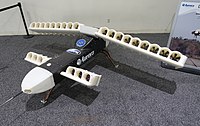
Photo from wikipedia
Abstract The increasing use of unmanned aerial vehicles and micro air vehicles creates a strong demand for the accurate aerodynamic performance of small-diameters fixed-pitch propellers. The techniques range from low-fidelity… Click to show full abstract
Abstract The increasing use of unmanned aerial vehicles and micro air vehicles creates a strong demand for the accurate aerodynamic performance of small-diameters fixed-pitch propellers. The techniques range from low-fidelity to high-fidelity methods. Among the low-fidelity techniques, there is the blade element momentum theory (BEMT). Computational fluid dynamics (CFD) is categorized as a high-fidelity method. This study aims to employ these methods for the analysis of an APC propeller 14 × 7e. Geometric modeling was performed in a 3D scanner and simulations via BEMT and CFD. Analyses using the BEMT model were conducted with two formulations. The first one considered a linear lift coefficient up to the stall limits, without specifying the post-stall lift coefficients. The second one incorporates three-dimensional flow equilibrium effects, and best represents the post-stall conditions. In the CFD models, two approaches for the compatibility of the rotating and stationary domains were evaluated, the stationary frozen rotor (FR) and the transient arbitrary mesh interface (AMI). The kω SST turbulence model was employed. To investigate the influence of the transition laminar-turbulent boundary layer, the Gamma Theta transitional model was also considered. In the comparison of the results with the experimental tests, it was observed that the appropriate choice of analysis method had a strong relationship with the Reynolds number. For low advanced ratio velocities, the best results were obtained with the BEMT models. BEMT linear model overpredicted the power and efficiency for high advance ratio, while BEMT with tridimensional flow equilibrium presented consistent results with a low computational cost. On the other hand, the CFD-AMI model shows better results for higher advanced ratio velocities but is computationally more expensive. The CFD-FR model maintains a constant pattern of error that, in the analysis of efficiency, did not compromise the results.
Journal Title: Aerospace Science and Technology
Year Published: 2021
Link to full text (if available)
Share on Social Media: Sign Up to like & get
recommendations!